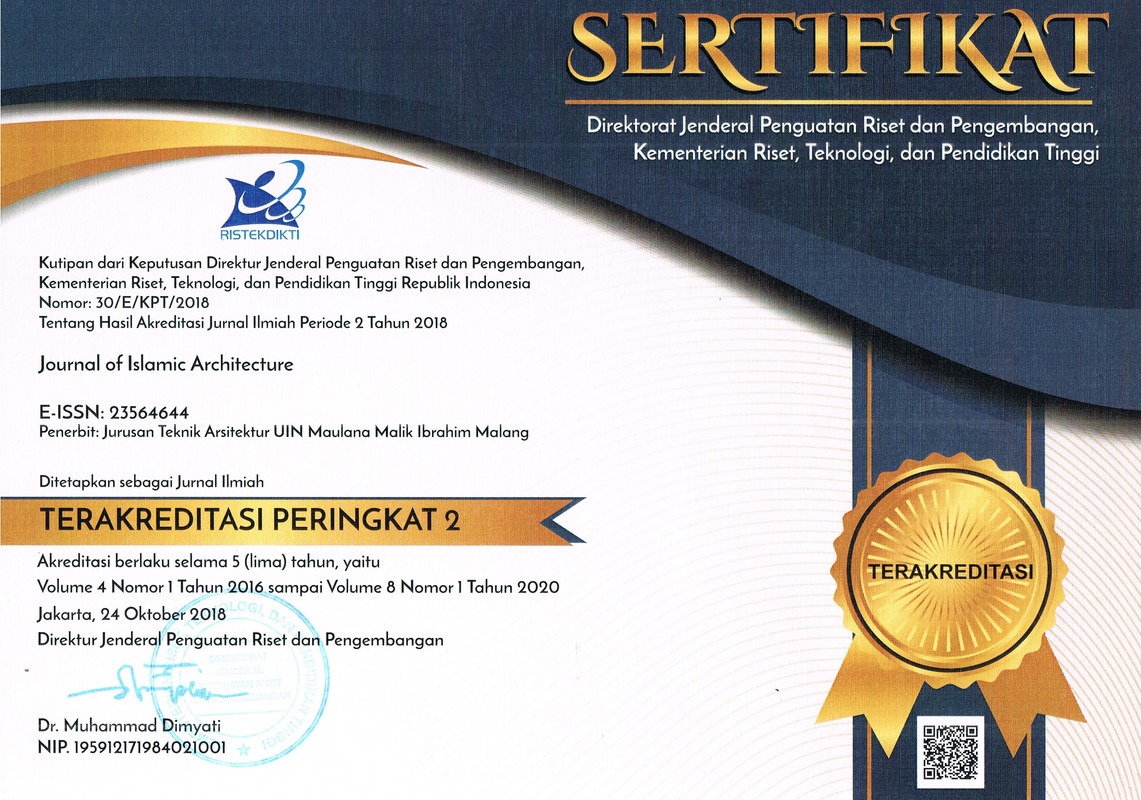INTEGRATION OF REVEALED KNOWLEDGE INTO DESIGN THINKING: AN URBAN DESIGN STUDIO EXPERIMENT
Abstract
Integration of human knowledge principle has been widespread in the world of Islamic education, including in Indonesia. Partially seen as an attempt to build a school of thought of architecture education, the principle opens the discussion on the discursive level of design thinking. This paper reveals an explorative effort to translate the idea into a class experiment in an architectural design studio. This class experimental research uses a content analysis of students’ reflective writing who involve the design process that deliberately begins with the introduction of revealed knowledge (Arabic: wahy) in Architectural Design Studio 7 at the Department of Architecture, Universitas Islam Indonesia. In conclusion, it has formulated a dynamic and multi-dimensional construction of design thinking based on the integration of knowledge
Keywords
Full Text:
PDFReferences
Presidential Regulation No. 8 of 2012 concerning Indonesia Qualification Framework (Peraturan Presiden RI Nomor 8 Tahun 2012 tentang Kerangka Kualifikasi Nasional Indonesia, KKNI).
Regulation of Minister of Education and Culture No. 73 of 2014 concerning the Application of IQF in Higher Education (Permendikbud Nomor 73 Tahun 2014 tentang Penerapan KKNI Bidang Pendidikan Tinggi).
Universitas Islam Indonesia, 72nd Anniversary of Universitas Islam Indonesia (translated from 9 Windu Universitas Islam Indonesia. Yogyakarta: UII Press, 2015.
K. Hassan, A Return to the Qur’anic Paradigm of Development and Integrated Knowledge: The Ulil Albab Model, (2), 183–210, 2010.
N. Kholis, I.F. Maharika & F. Wahid, “Recasting the Disciplines Under the Framework of Islam: Lessons from the Textbook Writing Initiative at Universitas Islam Indonesia,” Proceedings of the International Conference in the Integration of Contemporary and Islamic Knowledge in Islamic Universities, Gontor, Indonesia, 12-14 December, 2015.
A. M. Salama, (Ed.) “Design Studio Teaching Practices: Between Traditional, Revolutionary, and Virtual models,” Open House International, 31(3), pp. 1-116, 2006.
A. M. Salama, “A Theory for Integrating Knowledge in Architectural Design Education,” Archnet-IJAR, International Journal of Architectural Research, Vol 2, Issue 1, March, 2008.
H. W. Rittel & M. A. Webber, “Dilemmas in a General Theory of Planning,” Policy Sciences, 4, pp. 155–169, 1973.
J. C. Jones, Design methods. NY: John Wiley & Sons, 1992.
J. C. Jones, “A Method of Systematic Design” in Cross N. (ed) Development in Design Methodology, NY: John Wiley & Sons, pp. 9-32, 1984.
J. Darke, “The Primary Generator and the Design Process,” Design Studies, Volume 1, Issue 1, pp. 36-44, ISSN 0142-694X, http://dx.doi.org/10.1016/0142-694X(79)90027-9 (http://www.sciencedirect.com/science/article/pii/0142694X79900279) 1979.
P. Rowe, Design Thinking. Cambridge MA: MIT Press, 1987.
N. Cross, Design Thinking, Understanding How Designer Think, Oxford, New York, Berg, 2011.
K. M. Murphy, J. Ivarsson, & G. Lymer, (2012). “Embodied Reasoning in Architectural Critique”, Design Studies, 33(6), 530–556. https://doi.org/10.1016/j.destud.2012.06.005.
K. Dorst, “The Core of ‘Design Thinking’ and Its Application”, Design Studies, 32, 2011, doi:10.1016/j.destud.2011.07.006.
J. Kolko, “Design Thinking Comes of Age,” Harvard Business Review, 2015, [retrieved from https://hbr.org/2015/09/design-thinking-comes-of-age, 2017-01-05].
R. L. Martin, “Use Design Thinking to Build Commitment to a New Idea,” Harvard Business Review, 2017 [retrieved from https://hbr.org/2017/01/use-design-thinking-to-build-commitment-to-a-new-idea,2017-01-05].
J. Lahey “How Design Thinking Became a Buzzword at School”, The Atlantic, 2017 [retrieved from https://www.theatlantic.com/education/archive/2017/01/how-design-thinking-became-a-buzzword-at-school/512150, 2017-01-05].
Term of Reference, Architectural Design Studio 7, 2016 [in Bahasa Indonesia].
Al Quran retrieved from https://quran.com
K. Krippendorff, Content Analysis: An Introduction to Its Methodology (2nd ed.). Thousand Oaks, CA: Sage. p. 413. ISBN 9780761915454, 2004.
T. Hartmann, “Wicked Problems and Clumsy Solutions: Planning as Expectation Management,” Planning Theory, 11(3), pp. 242-256, 2012.
R. M. Roberts, “Serendipity: Accidental Discoveries in Science,” Serendipity: Accidental Discoveries in Science, by Royston M. Roberts, Pp. 288. ISBN 0-471-60203-5. Wiley-VCH, June 1989., 288, 1989.
R. H. Liang, “Designing for Unexpected Encounters with Digital Products: Case studies of Serendipity as Felt Experience,” International Journal of Design, 6(1), 41-58, 2012.
P. Yuan, Y. Xiong, Y. Li, L. Liu, & M. Li, (2017). “An Exploration into the Influence of Stimulation Distance of Stimulus Information on Design Thinking Based on EEG Alpha Activity”, Jixie Gongcheng Xuebao/Journal of Mechanical Engineering, 53(15), 40-48. 2017 doi:10.3901/JME.2017.15.040.
E. van Dooren, E. Boshuizen, J. van Merriënboer. “Making Explicit in Design Education: Generic Elements in the Design Process,” International Journalof Technology and Design Education, 24: 53. doi:10.1007/s10798-013-9246-8, 2014.
DOI: https://doi.org/10.18860/jia.v5i1.4202
Refbacks
- There are currently no refbacks.
Copyright (c) 2018 Journal of Islamic Architecture

This work is licensed under a Creative Commons Attribution-ShareAlike 4.0 International License.
EDITORIAL OFFICE
Department of Architecture, Faculty of Science and Technology
Universitas Islam Negeri Maulana Malik Ibrahim Malang
Jalan Gajayana 50 Malang, Jawa Timur, Indonesia 65144
Phone (+62) 341 558933,Facsimile (+62) 341 558933
e-mail: journal.islamicarchitecture@gmail.com / jia@uin-malang.ac.id

This work is licensed under a Creative Commons Attribution-ShareAlike 4.0 International License.



